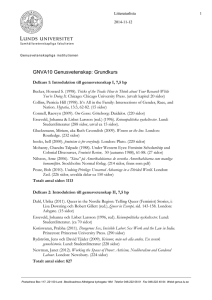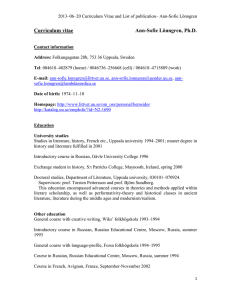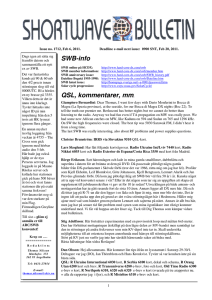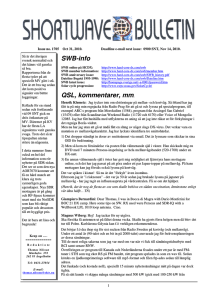Code-mixing as a window to cross
advertisement
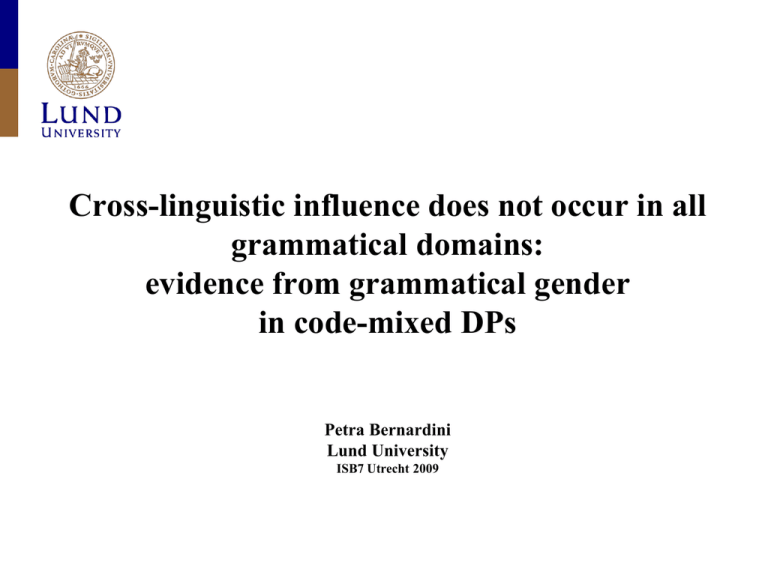
Cross-linguistic influence does not occur in all grammatical domains: evidence from grammatical gender in code-mixed DPs Petra Bernardini Lund University ISB7 Utrecht 2009 Outline of the talk 1. Introduction: Code-mixing as a window to cross-linguistic influence 2. Gender at the Lexicon/Syntax interface 3. The Bilingual Language Faculty 4. Previous studies on code-mixing and the acquisition of gender in Bilingual First Language Acquisition 5. Predictions 6. Claims 7. Results 8. Conclusions 9. References Lund university / Språk- och litteraturcentrum// Petra Bernardini/ISB7 Utrecht 2009 1. code-mixing as a window to crosslinguistic influence • code-mixing (here: the merging of two syntactic elements, head and XP) • in the language production of three longitudinally studied ItalianSwedish children, 2L1 • The acquisition of grammatical gender • Question: is there cross-linguistic influence in the acquisition of gender and can codemixed DPs tell us something about it? Lund university / Språk- och litteraturcentrum// Petra Bernardini/ISB7 Utrecht 2009 Code-mixing as a window to crosslinguistic influence Code-mixing • It appears in many but not all 2L1 corpora • It appears to be more frequent in the weaker language (Bernardini & Schlyter, 2004, see references quoted there) Cross-linguistic influence • It might be domain-specifik, i.e. It might be constrained to appear only at the syntax/pragmatics interface M&H (2001) • It might depend on language dominance (Lanza, 199X)) and/or amount of input Bernardini & Schlyter) Lund university / Språk- och litteraturcentrum// Petra Bernardini/ISB7 Utrecht 2009 Code-mixing as a window to crosslinguistic influence Is it safe to say that code-mixing is a kind of cross-linguistic influence? Maybe: code-mixing may be used as a strategy to develop the weaker language, although the two languages develop separately (B&S) and cross-linguistic influence too (i.e. Acceleration (Paradis & Genesee, 1996) But, how do we tell them apart? -s plurals in English/German 2L1, for ex. (Kupisch, 2009) Lund university / Språk- och litteraturcentrum// Petra Bernardini/ISB7 Utrecht 2009 2. Gender at the Lexicon-Syntax interface • Gender is both lexical assignment and grammatical agreement (disregarding semantic gender agreement) • It is therefore an abstract lexical feature (assignment) of the noun that project in someway in syntax in order to be grammaticaly checked (agreement) • Gender never appears in isolation in the languages of the world, but always parasites on something else in the languages that has gender (Greenberg, 1966) (projection) • The question is on which other feature it parasites Lund university / Språk- och litteraturcentrum// Petra Bernardini/ISB7 Utrecht 2009 Gender in Italian: in the lexicon • Nouns are subdivided lexically in two gender classes: masculine and feminine; • The gender of the noun can be seen on the ending of the lexical entry noun; • In Italian, gender manifests itself on the same morpheme as number; • The indefinite and the definite article are free morphemes; • It is marked both in the indefinite and in the definite DP Lund university / Språk- och litteraturcentrum// Petra Bernardini/ISB7 Utrecht 2009 Gender in Italian (1) Una casa rossa/la casa rossa ‘a red house/the red house’ f. f. f. /f. f. f. (2)Delle case rosse/le case rosse ‘red houses/the red houses’ f.pl.indef f.pl. f.pl./ f.pl.def f.pl. f.pl. Lund university / Språk- och litteraturcentrum// Petra Bernardini/ISB7 Utrecht 2009 Gender in Italian: checking in syntax Lund university / Språk- och litteraturcentrum// Petra Bernardini/ISB7 Utrecht 2009 Gender in Swedish: lexicon • Swedish nouns are not ‘visibly’ marked for gender, but they are subdivided in gender classes; • COMMON GENDER=N-Gender, since the article ends in -n (en/-(e)n) • NEUTER GENDER= T-Gender, since the article ends in t (ett/-(e)t) • Gender is not marked by the same morpheme as number on the noun, but together with the indefiniteness/definiteness morphemes (4); • The indefinite article is a free morpheme but the indefinite one is a bound morpheme, enclitic to the noun; • Only the noun of the definite DP is marked for gender, by the enclitic definite article (5) Lund university / Språk- och litteraturcentrum// Petra Bernardini/ISB7 Utrecht 2009 Gender in Swedish • (5) a. en bok ’a book’ b. flera böcker ‘more books’ • a indet. C book several book-s PL • c. ett bord ‘a table’ d. flera bord ‘several books’ • a-indet. N table more PL table • (6) a. boken ’the book’ • book-det.c. • • c. bordet ’the table’ table-det. N b. böckerna ’the books’ book-pl.-det. N d. borden table-det. N Lund university / Språk- och litteraturcentrum// Petra Bernardini/ISB7 Utrecht 2009 ’the tables’ Gender in Swedish: adjectives Different forms indefinite/definite (7)a. en gammal gata b. den gamla gatan an-indet. old(indet.) road the-det.C old(det.) road-det.C Different forms Common/Neuter (8)a. Ett gammalt hus b. Det gamla huset an-ind. Old N house The-def. N old house-def. N Lund university / Språk- och litteraturcentrum// Petra Bernardini/ISB7 Utrecht 2009 Gender in Swedish: checking in syntax Lund university / Språk- och litteraturcentrum// Petra Bernardini/ISB7 Utrecht 2009 Gender at the Lexicon-Syntax interface Bessler, Cummins, Nadasdi & Roberge (1993) ”We refer to this level as the Lexicon-Syntax Interface, or LSI. The function of the LSI is to process lexical items drawn from the lexicon so that they may be treated in syntax. Intuitively, then, the LSI is the level of grammar responsible for what is generally referred to as inflectional morphology. The LSI associates unordered bundles of features to lexical items. A checking mechanism applies in syntax to ensure a match between syntactically relevant feature specifications and morphological specifications. The lexical items contextualized in a syntactic representation through X-bar theory are then processed through the interface level between syntax and Phonological Form, where language-particular templates, of the kind devised by Bonet 1991 ensure that the representation satisfies the principle of Full Interpretation at PF. Otherwise, the representation crashes at PF.” Lund university / Språk- och litteraturcentrum// Petra Bernardini/ISB7 Utrecht 2009 3. The bilingual language faculty MacSwan (2000) Lund university / Språk- och litteraturcentrum// Petra Bernardini/ISB7 Utrecht 2009 Previous studies on code-mixing and the acquisition of gender in Bilingual First Language Acquisition Cantone & Müller (2007) and Cantone (2007) • the gender of the code-mixed DP will be that of the noun and gender will be checked grammatically (Gender is a lexical inherent feature of the noun that does not project in syntax • Four German/Italian bilingual longitudinal child corpora • 85% of code-mixed DPs confirm this hypothesis Bernardini (2004) • Gender is a lexical inherent feature of the noun that does project in syntax by being hosted by another functional head, which differ cross-linguistically • The gender of the code-mixed DP will fail to be checked • Two bilingual children whose data followed this pattern Lund university / Språk- och litteraturcentrum// Petra Bernardini/ISB7 Utrecht 2009 Questions regarding previous studies 1. Where the Swedish data to few to give a complete picture? Answer: probably, that’s why it should be studied more 2. Does the language combination matter in the code-mixing of gender? Answer: probably, but we have to look at more language combinations to be sure Lund university / Språk- och litteraturcentrum// Petra Bernardini/ISB7 Utrecht 2009 Problems with different gender system combinations in code-mixing a. Italian French la mer (F) b. Italian German ? meer (N) c. Italian English ? sea d. Italian Swedish ? Hav (N) French Italian (two genders, the same) le mare (M) German Italian (two/three genders, +/the same der mare (M) English Italian (two genders/no gender) the mare (M) Swedish Italian (two genders/not the same) ? mare (M) Lund university / Språk- och litteraturcentrum// Petra Bernardini/ISB7 Utrecht 2009 What do we mean by grammatical gender and what does the child know about it? • Markdness: frequency? • Labels: ”Masculine” ”Feminine” but ”Neuter” ”Common” Lund university / Språk- och litteraturcentrum// Petra Bernardini/ISB7 Utrecht 2009 Previous studies on the acquisition of gender, (a couple of them) • Easy for 2L1children, compared to adults (Andersson (1993), Chini (1995), Granfeldt (2003), Bernardini (2004), etc.) • Easy for monolingual Italian children (Chini, 1995) • More difficult for bilingual German/French/Italian children disregarding language balance, but more easy with Italian (Kupisch et al.) Lund university / Språk- och litteraturcentrum// Petra Bernardini/ISB7 Utrecht 2009 Evidence and predictions for or against cross-linguistic influence in the acquisition of gender in 2L1 CROSS-LINGUISTIC INFLUENCE • the determiner in the mixed DP will have the gender value of the equivalent noun in the other language. • bilingual children would be expected to behave differently from monolingual children, presumably making more/different gender errors, than their monolingual peers. NO CROSS-LINGUISTIC INFLUENCE • the determiner of the mixed DP will not have gender, i.e. it will be produced in the unmarked/default value • bilingual children will acquire gender with the same amount and the same type of gender errors as their monolingual peers. Lund university / Språk- och litteraturcentrum// Petra Bernardini/ISB7 Utrecht 2009 Claims We claim that cross-linguistic influence is not possible in the bilingual acquisition of gender in Swedish and Italian since: • Gender is a lexical feature of the noun; • Bilingual children’s lexicons are represented separately; • Gender is projected in syntax by being hosted by a functional head that varies cross-linguistically; • Italian and Swedish do not have the same gender system, gender is projected hosted by different functional heads in the two languages. Lund university / Språk- och litteraturcentrum// Petra Bernardini/ISB7 Utrecht 2009 Results • Agreement between determiner, adjectives and nouns were studied in three Italian/Swedish children • Lina, Lukas, Annika (Longitudinally studied, Ages 2-3;5) • All three acquire gender in Italian with an agreement and assignment error % below 5% • Annika and Lukas, same in Swedish • Lukas’ few errors in Swedish consist in using -n gender instead of -t gender • Code-mixed DPs constitue a low but interesting % Lund university / Språk- och litteraturcentrum// Petra Bernardini/ISB7 Utrecht 2009 Results Lukas and Lina only code-mix in one direction: determiner in the stronger language and noun in the weaker language Lukas’ Total DPs with determiner Italian: 127, 5 gender err Swedish: 537, gender err below 10 Lina’s Total DPs with determiner Italian: 204, 2 gender err Lund university / Språk- och litteraturcentrum// Petra Bernardini/ISB7 Utrecht 2009 Results Annika 4 files studied: ages 2;11 (code-mixes found) and 3;10 (no c.mixes) Age 2;10 (MLU: ITA 2.9 SWE 3.9) Total DPs with determiner: Italian: 58, 1 gender err Swedish: 67, 1 gender err Lund university / Språk- och litteraturcentrum// Petra Bernardini/ISB7 Utrecht 2009 Annika 2;11: Gender errors and code-mixed DPs Total gender errors: 2 Quella elefante ’that-F elephant-M’ En skor ’a-C shoes-PL’ Total code-mixed DPs: ITA files: 3 il sitrone IT SWE/IT ’the-M LEMON la nyckelpiga IT SWE The-F ladybird-C SWE files: 2 Sin coperto SWE IT ’his-C ’blanket-M+ending-O instead of -a’ i svanzi IT SWE/IT ’the-M tail-PL/M-IT Lund university / Språk- och litteraturcentrum// Petra Bernardini/ISB7 Utrecht 2009 Lukas, 2:0-3;7: Gender in code-mixed DPs (1:2) Lukas a. en casetta [ett hus (n)](2;1, Sw MLU, 1.7; It MLU 1.1) b. är det en pera? [ett päron (n)] (2;1, Sw MLU, 1.7; It MLU, 1.1) ‘is this(n) a(c) pear?’ d. den är en coltello [en kniv (c)] (2;2, Sw MLU, 2.3; It MLU, 1.1) ‘that one(c) is a(c) knife’ e. en crotodillo [en krokodil(c)] (2;7, Sw MLU, 2.9; It MLU 1.7) f. ‘a(c) crocodile’ g. den andra macchinen [den andra bilen(c)] (2;7,21, Sw MLU, 2.8, It MLU, 2.2) ’the other(c) car-DET(c)’ Lund university / Språk- och litteraturcentrum// Petra Bernardini/ISB7 Utrecht 2009 Lukas, 2:0-3;7: Gender in code-mixed DPs h. denna ’this(c) la macchina [denna(c) bilen(c) (2;7,21, Sw MLU, 2.8, It MLU, 2.2) the car’ i. denna här macchina ’this one here [denna här bil(c)] (2;7,21, Sw MLU, It MLU, 2.2) car’ Lund university / Språk- och litteraturcentrum// Petra Bernardini/ISB7 Utrecht 2009 Lina, 1;8-3;7: Gender in code-mixed DPs a. un ben [ett ben(n)] ‘a leg’ b. il mio bok [min bok(c)] (2;2, It MLU, 2.4, Sw MLU, 1.1) (2;10,5, It MLU, 2.7, Sw MLU, 1.2) ’the my book’ Lund university / Språk- och litteraturcentrum// Petra Bernardini/ISB7 Utrecht 2009 Conclusions • The Swedish/Italian 2L1 children do not make any gender errors that are different from those that monolingual children make, nor more errors; • in most cases they use the ’unmarked’ gender on the determiner of the mixed DP; • These data might support the idea that gender would be absent in code-mixed DPs were Swedish and Italian are involved since it projects by different functional heads in syntax; • There is however one case where the gender of the determiner is that of the noun ’la nyckelpiga’ (Feminine+Common) • We need more data of languages with different gender systems! • We need data of adult bilinguals code-mixed DPs • Elicitation test on gender assignment/agreement is needed Lund university / Språk- och litteraturcentrum// Petra Bernardini/ISB7 Utrecht 2009 Selected References Bernardini, P. (2004) L’acquisizione dell’italiano come prima e seconda (madre)lingua): indagine longitudinale sulla sintassi del DP. Études romanes de Lund, 71. Phd Thesis. Lund Univeristy. Bernardini, P. & Schlyter, S. (2004) “Growing syntactic structure and the weaker language: the Ivy hypothesis.” Bilingualism: Language and Cognition, 7 (1), 49-69. Bessler, P. , Cummins, S, Nadasdi, T. & Y. Roberge (1993) “The Lexicon-Syntax Interface.” Toronto Working Papers in Linguistics, Vol 12. Cantone, K. & Müller, N. (2007). Un nase or una nase? What gender marking within switched DPs reveals about the architecture of the bilingual language faculty. Lingua 118 (2008), 810-826. Cantone, K. (2007) Code-switching in Bilingual Children (Studies in Theoretical Psycholinguistics). New York: Springer. Hulk, A. and Müller, N. (2001) Bilingual first language acquisition at the interface between syntax and pragmatics. Bilingualism, Language & Cognition, 3(3) 227-244. MacSwan, J. (2000) ”The Architecture of the Bilingual Language Faculty: evidence from intrasentential codeswitching. Bilingualism: Language & Cognition, 3(1). XX-XX. Lund university / Språk- och litteraturcentrum// Petra Bernardini/ISB7 Utrecht 2009 Thank you! petra.bernardini@rom.lu.se Lund university / Språk- och litteraturcentrum// Petra Bernardini/ISB7 Utrecht 2009
